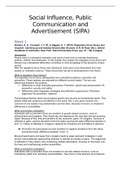Samenvatting
Understanding summary of all 7 articles of the course Social Influence, Public Communication and Advertising (SIPA)
- Instelling
- Universiteit Utrecht (UU)
Extensive and understanding summary of all 7 articles of the course Social Influence, Public Communication and Advertising. The articles included are: Scholer et al. (2019), Berger (2020), Cialdini (2001), Huta (2016), Schwartz (2012), Matz et al. (2017) and Berger (2014).
[Meer zien]




